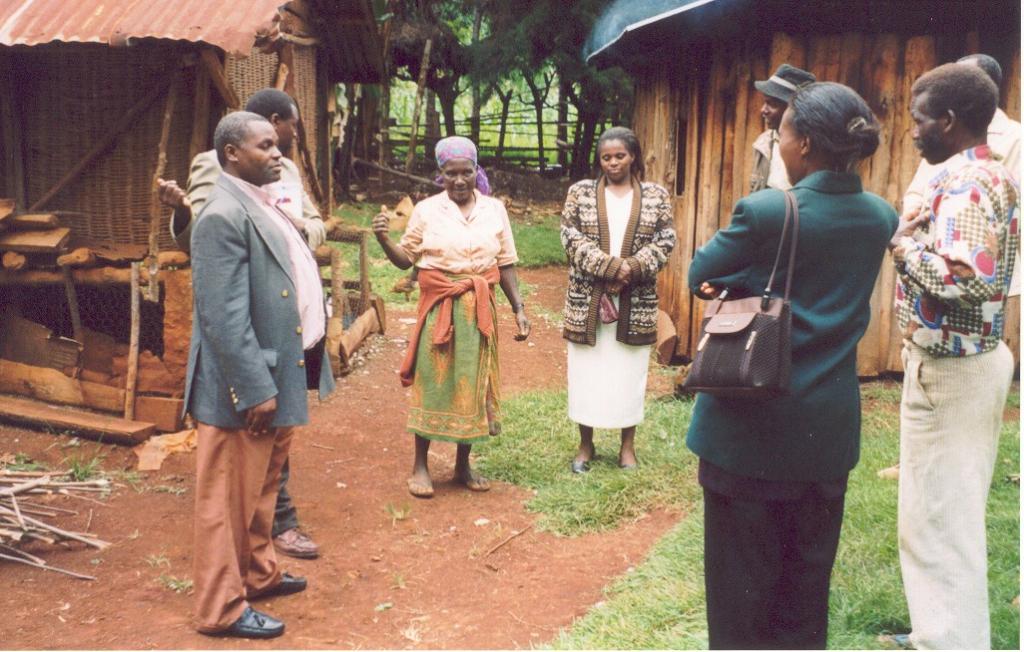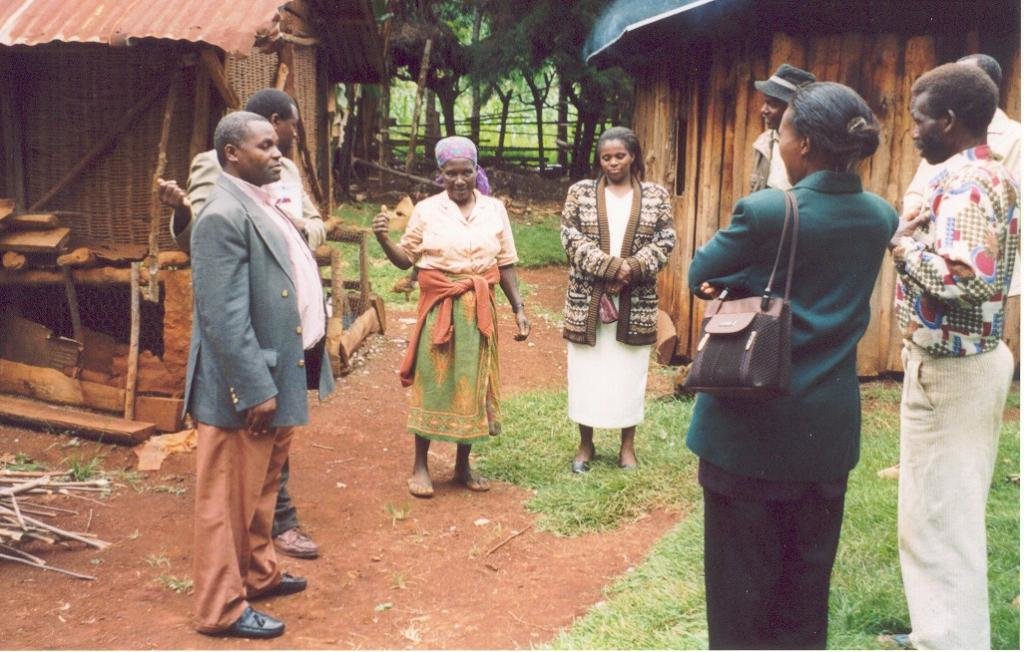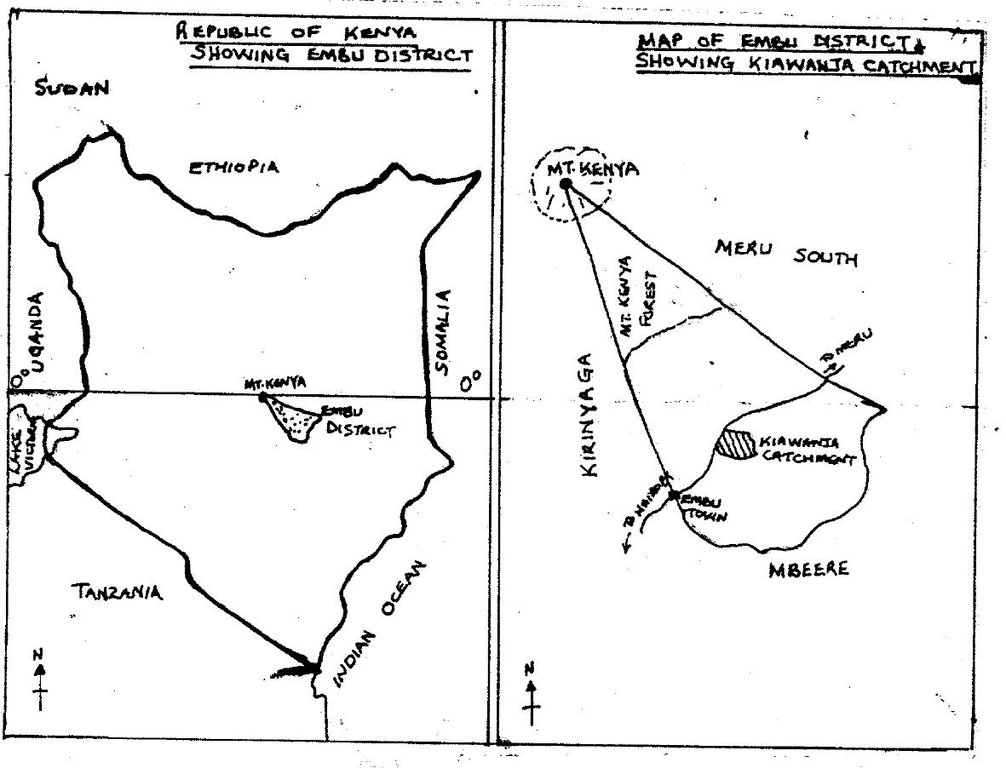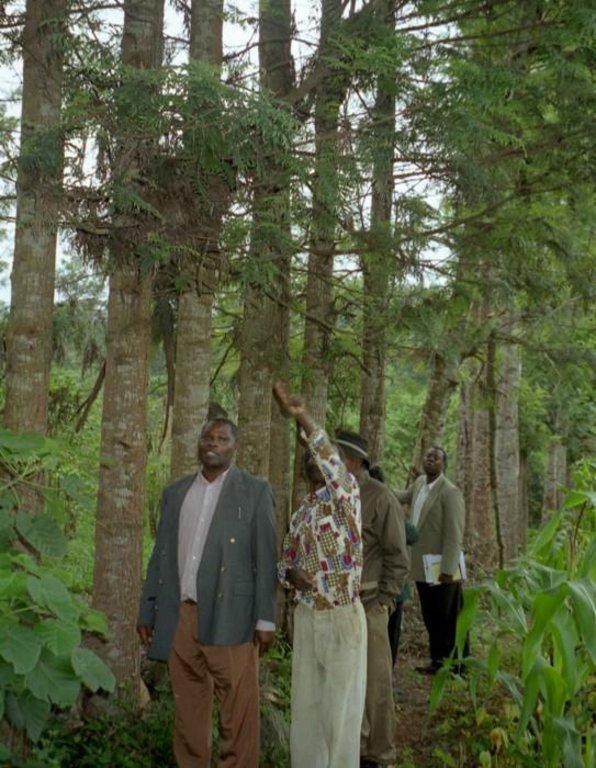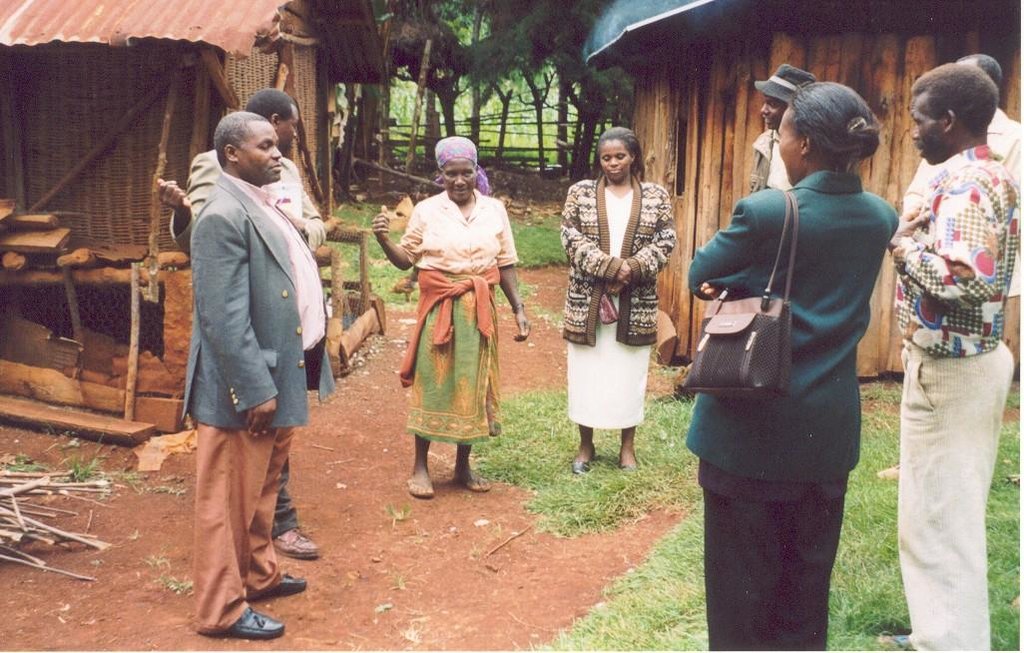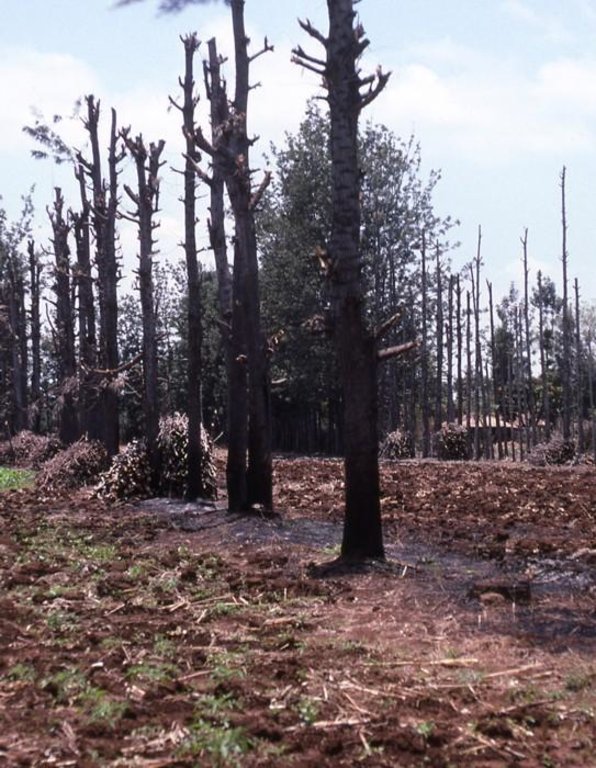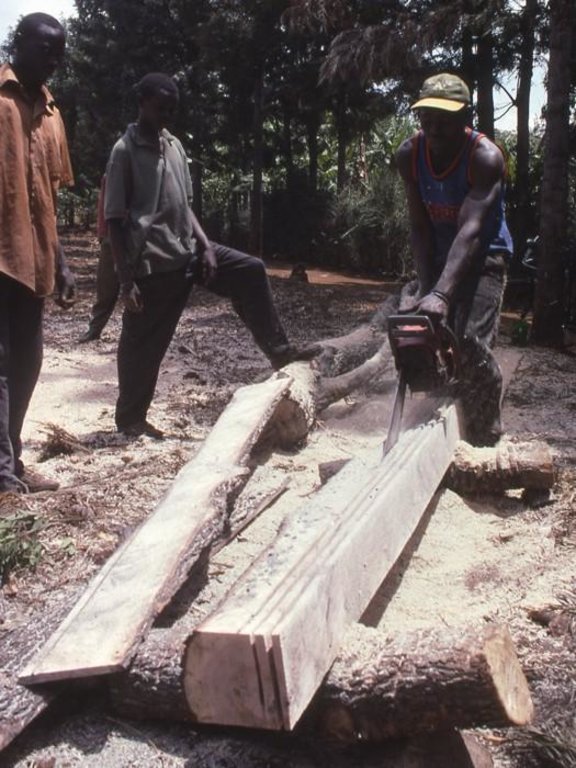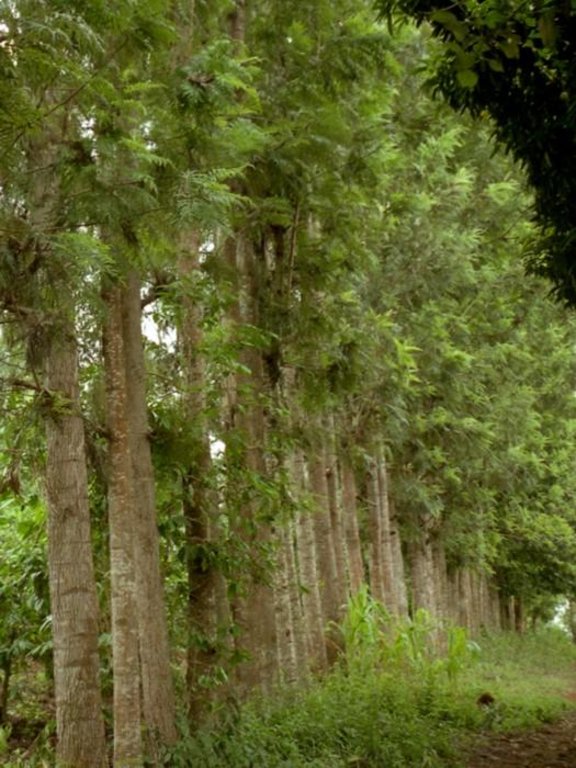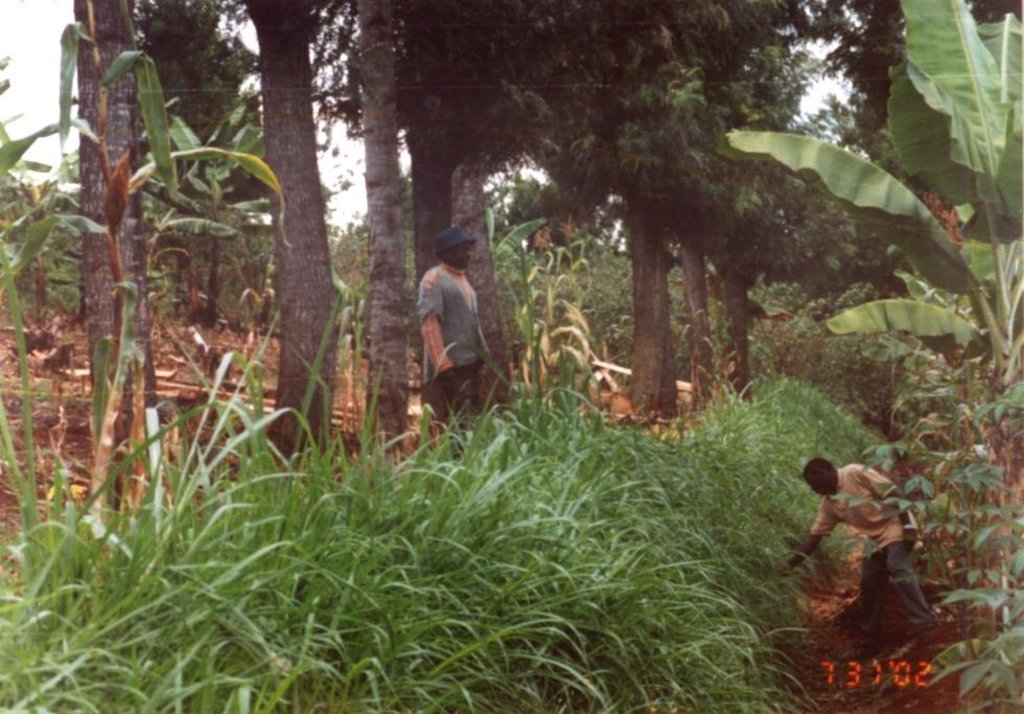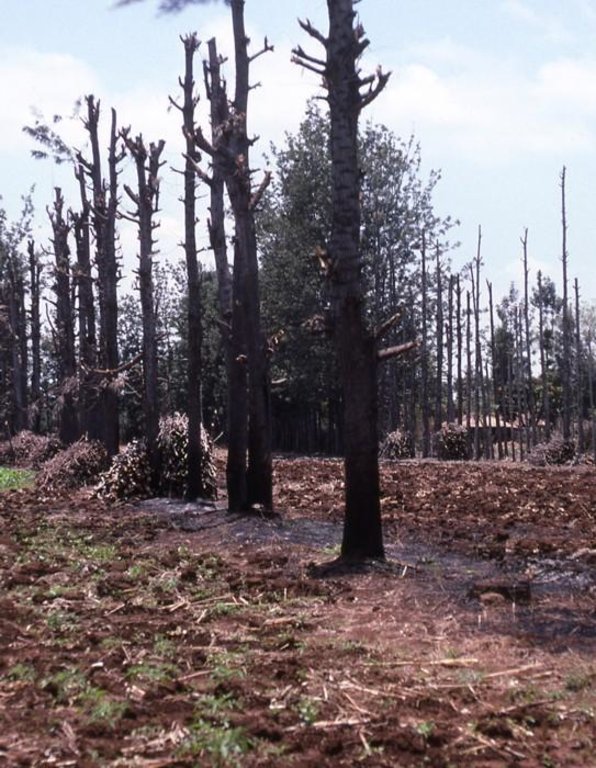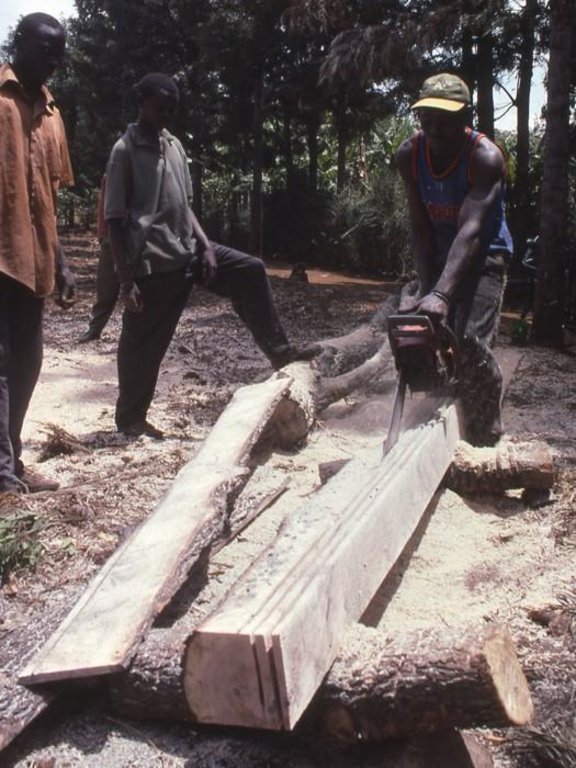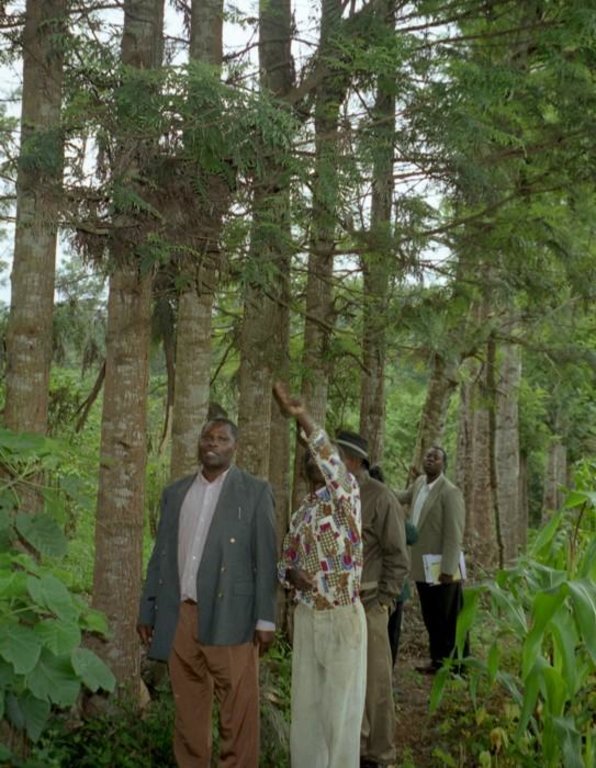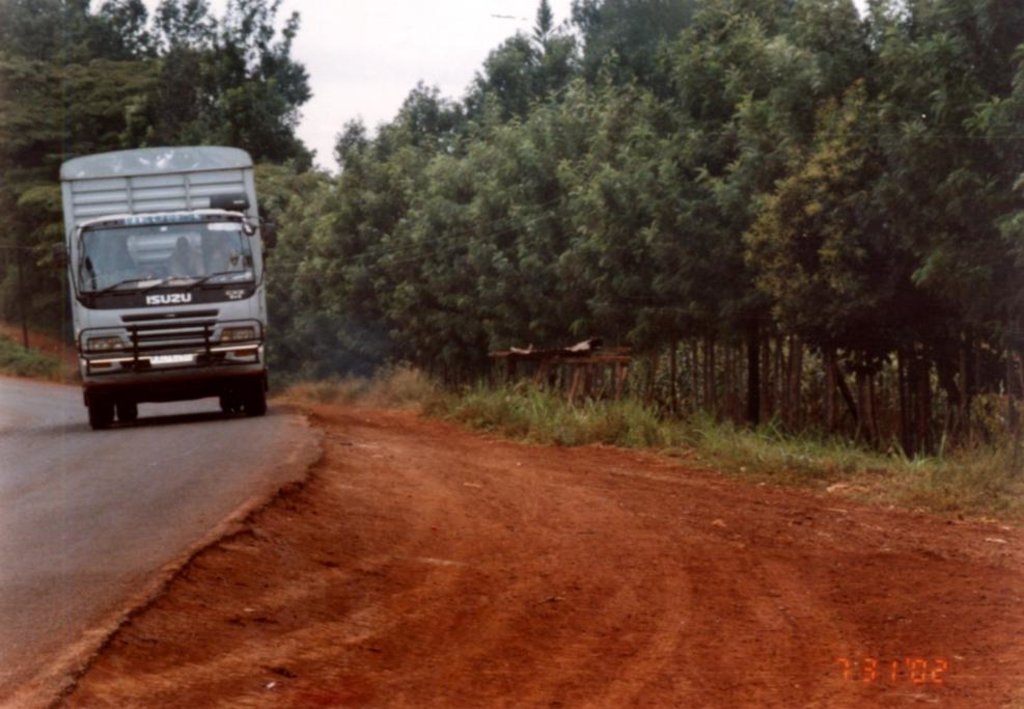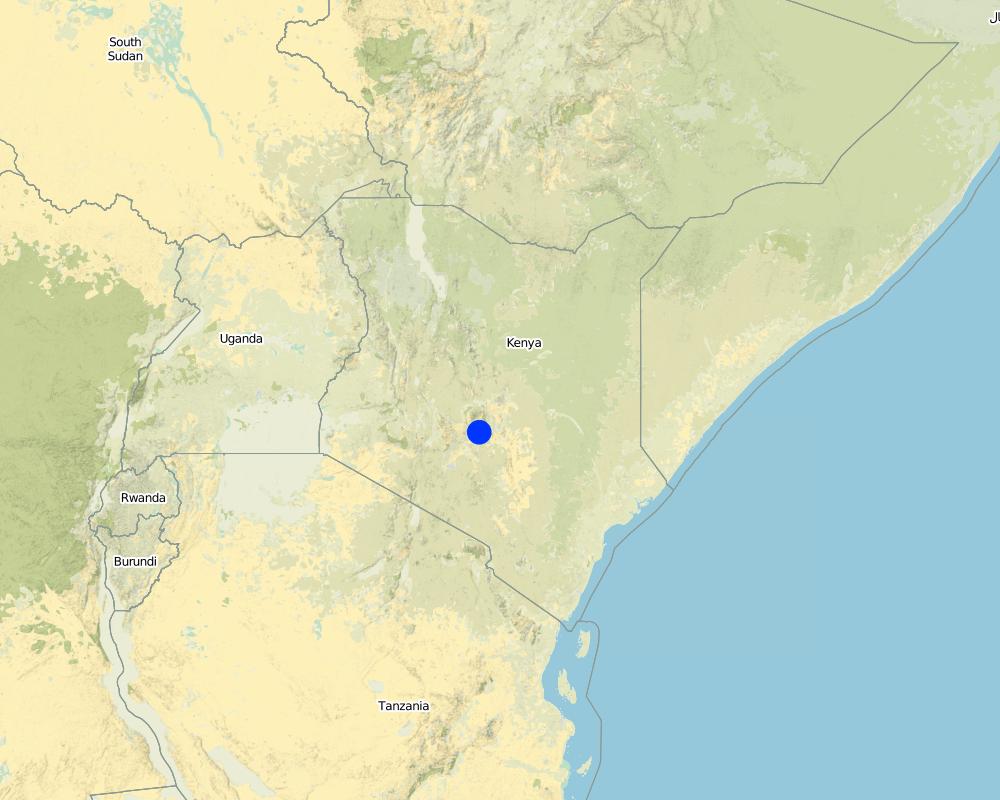Spontaneous spread [Kenia]
- Creación:
- Actualización:
- Compilador: Ceris A. Jones
- Editor: –
- Revisores: Fabian Ottiger, Deborah Niggli
approaches_2627 - Kenia
Visualizar secciones
Expandir todo Colapsar todos1. Información general
1.2 Detalles de contacto de las personas de referencia e instituciones involucradas en la evaluación y la documentación del Enfoque
Especialista MST:
Mwaniki JM
mwanikijm2002@yahoo.com
Ministry of Agriculture/Soil and Water Conservation Branch
Embu
Kenia
Especialista MST:
Nombre del proyecto que facilitó la documentación/ evaluación del Enfoque (si fuera relevante)
Book project: where the land is greener - Case Studies and Analysis of Soil and Water Conservation Initiatives Worldwide (where the land is greener)Nombre de la(s) institución(es) que facilitaron la documentación/ evaluación del Enfoque si fuera relevante)
Ministry of Agriculture, Livestock and Fisheries (MoA) - KeniaNombre de la(s) institución(es) que facilitaron la documentación/ evaluación del Enfoque si fuera relevante)
Swiss Agency for Development and Cooperation (DEZA / COSUDE / DDC / SDC) - SuizaNombre de la(s) institución(es) que facilitaron la documentación/ evaluación del Enfoque si fuera relevante)
Agronomica - Reino Unido1.3 Condiciones referidas al uso de datos documentados mediante WOCAT
El compilador y la/s persona(s) de referencia claves aceptan las condiciones acerca del uso de los datos documentados mediante WOCAT :
Sí
1.4 Referencia/s al/los Cuestionario(s) de Tecnologías MST
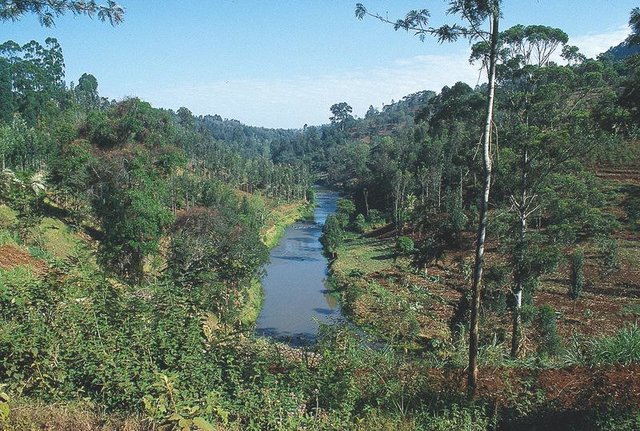
Système agroforestier à Grevillea [Kenia]
Les arbres de Grevillea robusta à usage multiples sont plantés le long les limites des champs, sur les talus des terraces et des fois dispersés dans les champs.
- Compilador: Ceris A. Jones
2. Descripción del Enfoque MST
2.1 Breve descripción del Enfoque
Spontaneous land users' initiative to meet household needs - especially firewood and timber - through planting Grevillea robusta trees as part of an agroforestry system.
2.2 Descripción detallada del Enfoque MST
Descripción detallada del Enfoque MST:
Aims / objectives: Grevillea robusta is a well-known shade tree, used in coffee and tea plantations in East Africa since the early part of the 20th century. While it originates from Australia, it was brought over from India and Sri Lanka by European settlers. Smallholder farmers in the highlands of Kenya noted that there was little or no competition between grevillea and neighbouring crops. Indeed this is one of the reasons it was so successful as a shade tree amongst plantation crops. Responding to the local lack of timber and firewood, due to the expansion of farmland into previously forested areas, smallholders took to planting grevillea, especially as a boundary tree, from the 1970s onwards. While the immediate effect of grevillea planting was to satisfy those needs for wood, the tree also helps in various ways to conserve land and improve the soil. This too was probably a reason for its spontaneous spread.
Methods: Because planting of grevillea requires few resources other than tools, even poor land users can readily adopt the technology. Although seedlings can be bought from local Government, NGO or private nurseries, it is also possible to collect ‘wildings’ (naturally generated seedlings) and plant these at minimal cost. The management of grevillea trees, once established, is important to their performance in the field, but the skills of thinning, and pollarding (pruning side branches for use) can be easily learned from neighbours. The success of the spontaneous spread of grevillea, basically through farmer-to-farmer exchange of knowledge, demonstrates that tree planting is not something that has always to be ‘pushed’ by outside agencies. Where smallholders perceive a need for trees and tree products - and an appropriate species is available - they will respond positively. However there is still an important ‘pulling’ role to be played by the Ministry of Agriculture’s extension agents and NGOs, especially through support for tree nurseries and for training to establish private tree nurseries.
2.3 Fotos del Enfoque
2.5 País/ región/ lugares donde el Enfoque fue aplicado
País:
Kenia
Región/ Estado/ Provincia:
Eastern Province
Map
×2.6 Fechas de inicio y conclusión del Enfoque
Indique año del inicio:
1971
2.7 Tipo de Enfoque
- tradicional/ local
2.8 Propósitos/ objetivos principales del Enfoque
The Approach focused mainly on other activities than SLM (Fencing, farm boundary marking, ornamental value, fuel wood supply, building materials provision)
- improve availability of tree products (fuelwood and wood for construction). - demarcate own land easily and cheaply (after land registration). - reduce land degradation. - increase land productivity. - improve household income
The SLM Approach addressed the following problems: - shortage of fuelwood and building materials, environmental degradation. - need for farm boundary marking. - lack of simple, widely applicable agroforestry recommendations
2.9 Condiciones que facilitan o impiden la implementación de la/s Tecnología/s aplicadas bajo el Enfoque
normas y valores sociales/ culturales/ religiosos
- impiden
Gender bias - women not expected to plant trees
Treatment through the SLM Approach: Although not directly related to this approach, intensive campaigns were conducted (by government and NGO's) to encourage gender balance with respect to tree planting
disponibilidad/ acceso a recursos y servicios financieros
- impiden
Shortage of tree seedlings and sourced from long distance
Treatment through the SLM Approach: Setting up of individual on-farm tree nurseries and collection of wildlings
marco de trabajo legal (tenencia de tierra, derechos de uso de tierra y agua)
- facilitan
The existing land ownership, land use rights / water rights greatly helped the approach implementation: Private land ownership has given farmers confidence to invest the land, and has also been a direct stimulus through the need to mark plot boundaries
conocimiento de MST, acceso a apoyo técnico
- impiden
Shortage of tree seedlings and sourced from long distance
Treatment through the SLM Approach: Setting up of individual on-farm tree nurseries and collection of wildlings.
3. Participación y roles de las partes interesadas involucradas
3.1 Partes interesadas involucradas en el Enfoque y sus roles
- usuarios locales de tierras/ comunidades locales
Working land users were mainly men (It was traditionally the role of men to plant trees. This is however changing ie other groups - women and youth - are now planting trees.)
Land users identified, purchased and planted their species of choice. However, at the same time, Grevillea seedlings were available at institutional (Ministry of Environment and Natural Resources) nurseries.
Traditionally men purchased, collected and planted trees. The men had greater access to and control of decisions on planting. The technology requires few resources, so that even poor land users have easily been able to decide to buy seedlings or collect wildlings and plant
3.2 Involucramiento de los usuarios locales de tierras/ comunidades locales en las distintas fases del Enfoque
| Involucramiento de los usuarios locales de tierras/ comunidades locales | Especifique quién se involucró y describa las actividades | |
|---|---|---|
| iniciación/ motivación | auto-movilización | innovative individuals planting grevillea |
| planificación | auto-movilización | informal, individual plans |
| implementación | auto-movilización | |
| monitoreo y evaluación | pasivo | ad hoc observations by MoA; |
| Research | ninguno | no activities |
3.4 La toma de decisiones en la selección de Tecnología(s) MST
Especifique quién decidió la selección de las Tecnología/ Tecnologías a implementarse:
- solamente usuarios de tierras (autoiniciativa)
Explique:
Land user-driven initiative by shortages/problems
Decisions on the method of implementing the SLM Technology were made by by land users* alone (self-initiative / bottom-up). The land user decided on when and how to plant the trees.
4. Apoyo técnico, fortalecimiento institucional y gestión del conocimiento
4.1 Construcción de capacidades / capacitación
¿Se proporcionó la capacitación a usuarios de tierras/ otras partes interesadas?
Sí
Temas avanzados:
Some demonstrations of benefits of tree planting by Government at provincial agricultural shows.
4.2 Servicio de asesoría
¿Los usuarios de tierras tienen acceso a un servicio de asesoría?
Sí
Especifique si servicio proporcionado se realizó:
- en los campos de los usuarios de tierras
Describa/ comentarios:
Key elements: Informal farmer-to-farmer exchange of ideas and skills. Additionally, on national tree planting days, the government hands out seedlings. Grevillea planting has been encouraged during national campaigns (involving the Ministry of Agriculture, the Ministry of Environment and Natural Resources, and NGOs) to encourage soil and w; 1) Advisory service was carried out through: other: individual land users 2) Advisory service was carried out through: other: individual land users
Advisory service is quite adequate to ensure the continuation of land conservation activities; There is collaboration between Government extension service and KARI (Kenya Agricultural Research Institute) to further promote the technology
4.3 Fortalecimiento institucional (desarrollo institucional)
¿Se establecieron o fortalecieron instituciones mediante el Enfoque?
- no
4.4 Monitoreo y evaluación
¿El monitoreo y la evaluación forman parte del Enfoque?
Sí
Comentarios:
technical aspects were ad hoc
economic / production aspects were ad hoc
area treated aspects were ad hoc monitored by 0 through observations; indicators: None
There were no changes in the Approach as a result of monitoring and evaluation: None
5. Financiamiento y apoyo material externo
5.1 Presupuesto anual para el componente MST del Enfoque
Comentarios (ej. fuentes principales de financiamiento/ donantes principales):
Approach costs were met by the following donors: government (national - Sponsored national tree planting days): 10.0%; other (Individual land user): 90.0%
5.2 Apoyo financiero/material proporcionado a los usuarios de tierras
¿Los usuarios de tierras recibieron financiamiento/ apoyo material para implementar la Tecnología/ Tecnologías? :
No
5.3 Subsidios para insumos específicos (incluyendo mano de obra)
- agrícola
| Especifique qué insumos se subsidiaron | En qué grado | Especifique los subsidios |
|---|---|---|
| semillas | parcialmente financiado | Individual land user. However, labour input was minimal |
Si la mano de obra de usuarios de tierras fue un insumo sustancial, ¿fue:
- voluntario?
Comentarios:
Individual land user. However, labour input was minimal
5.4 Crédito
¿Se proporcionó crédito bajo el Enfoque para actividades MST?
No
6. Análisis de impacto y comentarios de conclusión
6.1 Impactos del Enfoque
¿El Enfoque ayudó a los usuarios de tierras a implementar y mantener Tecnologías MST?
- No
- Sí, un poco
- Sí, moderadamente
- Sí, mucho
better soil and water management, increase in soil organic matter levels, nutrient pumping and reduced soil erosion.
Did other land users / projects adopt the Approach?
- No
- Sí, un poco
- Sí, moderadamente
- Sí, mucho
Other extension programmes are utilising individual initiative as an entry point
6.3 Sostenibilidad de las actividades del Enfoque
¿Pueden los usuarios de tierras sostener lo que se implementó mediante el Enfoque (sin apoyo externo)?
- sí
Si respondió que sí, describa cómo:
As land users developed this approach they can continue activities without support.
6.4 Fortalezas/ ventajas del Enfoque
| Fuerzas/ ventajas/ oportunidades desde la perspectiva del usuario de la tierra |
|---|
| Strong land user 'ownership' of the approach. |
| Adaptability, flexibilityand simplicity since it is user driven |
| Fuerzas/ ventajas/ oportunidades desde la perspectiva del compilador o de otra persona de referencia clave |
|---|
| Incentives not necessary |
| Valuable lessons from a farmer-driven success for development agencies that promote tree planting and agroforestry systems. |
| Very low inputs (resources) required. However there is still an important 'pulling' role to be played by the Ministry of Agriculture's extension agents and NGOs (How to sustain/ enhance this strength: More support for individual and government tree nurseries.) |
| Self-driven initiative (How to sustain/ enhance this strength: MoA extension staff and land users to encourage other farmers to be self-reliant.) |
6.5 Debilidades/ desventajas del Enfoque y formas de sobreponerse a ellos
| Debilidades/ desventajas/ riesgos desde la perspectiva del usuario de la tierra | ¿Cómo sobreponerse a ellas? |
|---|---|
| Lack of other stakeholders input | Encourage and inform land users on where to seek additional information consultations with SWC extensionists |
| Debilidades/ desventajas/ riesgos desde la perspectiva del compilador o de otra persona de referencia clave | ¿Cómo sobreponerse a ellas? |
|---|---|
| Adoption rates under such approaches depend on the number and efforts of innovators to stimulate others | SWC extensionists (Ministry and NGOs) to undertake more community mobilisation and awareness raising. |
| Approach is dependent on social cohesiveness for dissemination | promote more farmer interaction at community level |
| Poor collaboration and insitutional linkages | Encourage and create forums where stakeholders can share experiences and inform land users about where to seek additional information and assistance. |
7. Referencias y vínculos
7.1 Métodos/ fuentes de información
- visitas de campo, encuestas de campo
- entrevistas con usuarios de tierras
7.2 Referencias a publicaciones disponibles
Título, autor, año, ISBN:
NjiruN.N et al. 1998. PRA report of Kiawanja catchmentSee 'Grevillea agroforestry system' case study (QT KEN16) for technical references
¿Dónde se halla disponible? ¿Costo?
Nembure district
Vínculos y módulos
Expandir todo Colapsar todosVínculos

Système agroforestier à Grevillea [Kenia]
Les arbres de Grevillea robusta à usage multiples sont plantés le long les limites des champs, sur les talus des terraces et des fois dispersés dans les champs.
- Compilador: Ceris A. Jones
Módulos
No se hallaron módulos


